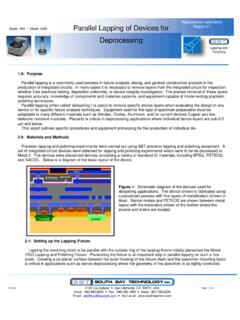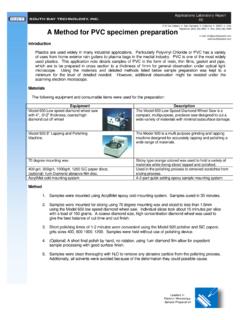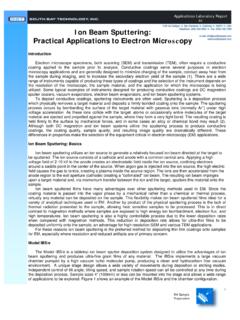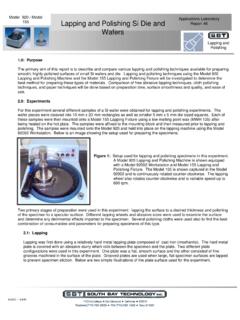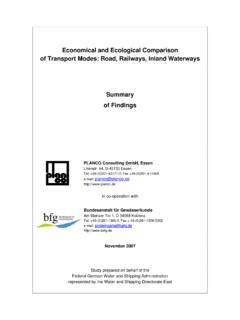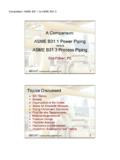Transcription of Evaluating Surface Roughness of Si Following …
1 1 Lapping and Polishing Purpose Lapping and polishing of samples is a common application and required for a variety of manufacturing and research processes. A wide range of techniques and methods can be implemented for any given polishing process and the type selected depends on the ultimate requirements of the sample. Surface finish, sample flatness and parallelism, and Surface quality are all to be considered when selecting a polishing process. Each process type has different overall characteristics and can be of greater benefit depending on the final application of the sample. This report will demonstrate typical Surface Roughness measurements of silicon samples processed using different polishing techniques. Materials and Methods Sample Polishing Lapping and polishing techniques can be divided into basically three types of processes: 1) Free abrasive on a hard lapping plate Surface , 2) Fixed abrasive in the form of papers or films, and 3) Free abrasive on a cloth-like Surface .
2 All three of these methods are common in materials preparation and the selection of one process over another depends on the sample and application of the sample as well as user preference. For this report several Si wafer pieces were obtained and cleaved into sections approximately 1cm2 x 700 m in thickness. These samples were then mounted to a Model 150 lapping and polishing fixture for preparation. Each sample was processed using diamond lapping film down to 3 m using a Model 920 Lapping and Polishing Machine. This was used as the starting Surface finish for all of the samples prior to processing for Surface Roughness measurements to ensure consistency in the process flow. Various processing times were used depending on the process selected. A basic illustration of the Model 920 using a Model 155 Lapping Fixture is given below. Figure 1: Image showing the basic arrangement used for polishing samples. The Model 920 Lapping and Polishing Machine is used with lapping plates, abrasive papers, abrasive films, or polishing cloths for sample preparation.
3 The Model 155 Lapping and Polishing Fixture is pictured as well, which is used for holding samples and controlling thickness during processing. Several different samples were prepared for the Surface Roughness measurements using different abrasive media. The experiment is designed to show differences in Roughness as it relates to sample processing techniques; therefore several samples were preparing using similar abrasive sizes combined with different methods to allow direct comparison of Roughness . Below is a list of all of the samples and their processing techniques used for this evaluation. Applications Laboratory Report 86 Evaluating Surface Roughness of Si Following Selected Lapping and Polishing Processes 2 Lapping and Polishing SAMPLE ABRASIVE SIZE ( M) PROCESS TIME (MIN) 1 DIAMOND LAPPING FILM PROCESS 5 2 1 DIAMOND LAPPING FILM PROCESS 5 3 COLLOIDAL SILICA SUSPENSION ON MULTITEX POLISHING CLOTH 15 4 1 ALUMINUM OXIDE SUSPENSION ON MULTITEX POLISHING CLOTH 15 5 1 ALUMINUM OXIDE SUSPENSION ON RAYON FINE POLISHING CLOTH 10 6 1 DIAMOND SUSPENSION ON RAYON FINE POLISHING CLOTH 15 7 12 ALUMINUM OXIDE SUSPENSION ON GLASS PLATE 10 8 12 ALUMINUM OXIDE SUSPENSION ON CAST FE LAPPING PLATE 10 9 6 DIAMOND SUSPENSION ON SANYPOL POLISHING CLOTH 15 10 6 DIAMOND SUSPENSION ON CHEMOTEX POLISHING CLOTH 15 11 15 DIAMOND SUSPENSION (TYPE L) ON COPPER COMPOSITE LAPPING PLATE 10 12 3 DIAMOND SUSPENSION (TYPE L)
4 ON COPPER COMPOSITE LAPPING PLATE 10 13 15 DIAMOND SUSPENSION (TYPE G) ON COPPER COMPOSITE LAPPING PLATE 10 14 3 DIAMOND SUSPENSION (TYPE G) ON COPPPER COMPOSITE LAPPING PLATE 10 15 1 DIAMOND SUSPENSION ON NYLON CLOTH (TYPE B) 15 16 1 DIAMOND SUSPENSION ON NYLON CLOTH (TYPE M) 15 Table 1: Table illustrating each of the samples prepared for the evaluation of Surface Roughness . Samples were processed using several different techniques to discover relationships between processing method and Surface Roughness . Surface Roughness Measurements Once the samples were processed and the Surface was prepared, each sample was evaluated using the Dektak 6m Surface profiler. This system is a stylus profiling instrument used for the measurement of Surface Roughness and other data as it relates to the sample. Stylus profilers are versatile measurement tools for studying Surface topography. The stylus profilers rely on a small-diameter stylus moving along a Surface either by movement of the stylus or movement of the Surface of interest.
5 A true stylus profiler moves linearly to obtain the measurement. As the stylus encounters Surface features, the stylus moves vertically to measure various Surface features, such as deposited film, irregularities, or finish [1]. Each sample was scanned after the polishing process to determine what the relative Roughness was. The Ra and RMS was calculated using the instrument software package and was plotted and graphed as a function of the line scan taken. 3 Lapping and Polishing Results All of the scans were taken using the same parameters as described in the section above. Roughness data were collected, giving the Ra and RMS both for each sample. A summary of the results is given in Table 2 below. SAMPLE RA ( ) RMS ( ) SAMPLE RA ( ) RMS ( ) 1 15 20 9 40 52 2 17 25 10 463 600 3 22 26 11 608 904 4 94 133 12 185 266 5 32 40 13 879 1239 6 57 84 14 195 253 7 3140 4087 15 24 30 8 3382 4684 16 23 29 Table 2.
6 Summary of Surface scan data giving the Ra and RMS values for each sample. Diamond Film Diamond lapping films are a type of fixed abrasive consumable that provides a high degree of flatness combined with excellent Surface finishing properties and removal rates. Diamond films are commonly used in SEM and TEM sample preparation processes and therefore it is useful to note what type of Surface finish these can produce. Two types of films were evaluated, m and 1 m, and are noted as sample 1 and 2, respectively. The Surface profile images are given below. From the scans it is clear that the Surface Roughness is much less than the particle size of the diamond film. m = 5000 , but the Surface Roughness or Ra is 15 , far better than what the diamond film should achieve. This shows the excellent finishing characteristics of these diamond lapping films. It is important to note that RMS is sometimes a better indication of the Surface characteristics due to the measurement techniques employed.
7 Figure 2: Surface profile scans of silicon wafer sample after polishing with m (left) and 1 m (right) diamond lapping films. The Ra was given as 15 and 17 , respectively. 4 Lapping and Polishing Free Abrasive Lapping on Plates Lapping using a variety of lapping plates can create different Surface Roughness depending on the sample, lapping plate material, and abrasive media. For these experiments three different lapping plates were used to investigate the Surface Roughness : 1) Glass, 2) Cast Fe (iron), and 3) Copper composite. Aluminum oxide (Al2O3) and diamond suspensions were used for the investigation, and each Roughness value was recorded Following processing of the sample. Aluminum Oxide Suspension Aluminum oxide suspension of 12 m particle size was used for lapping on the glass and cast Fe lapping plates. The Ra and RMS were found to be 3140 and 4087 for the glass plate and 3382 and 4684 for the cast Fe lapping plate. This shows that the glass plate produced an improved Surface finish over that obtained with cast Fe.
8 Figure 3 below shows the results obtained from these samples. Figure 3: Surface profile scans of silicon wafer sample after lapping with aluminum oxide suspension on glass plate (left) and cast Fe plate (right). The Ra was given as 3140 and 3382 , respectively. Diamond Suspension Two different diamond suspensions were used for this investigation and were used solely on copper composite lapping plates. Two different abrasive sizes were used, 15 m and 3 m from two different manufacturers. This test was used to investigate the differences in Surface Roughness produced by both diamond suspension types and to compare (roughly) the Surface Roughness produced by the three different lapping plate types. The fine diamond particle size was used as a comparison to other techniques such as polishing cloth methods. The results obtained from these tests are given in Figure 4 and 5 below. Figure 4: Surface profile scans of silicon wafer sample after lapping with diamond suspension on Cu composite plate using two different 15 m diamond suspensions.
9 The Ra was given as 608 for sample 11 at left and 879 for sample 13 at right. 5 Lapping and Polishing Figure 5: Surface profile scans of silicon wafer sample after lapping with diamond suspension on Cu composite plate using two different 3 m diamond suspensions. The Ra was given as 185 for sample 12 at left and 195 for sample 14 at right. Polishing Cloth Processing samples using a polishing cloth process to produce smooth, relatively scratch free surfaces is a common practice in sample preparation processes. Several different abrasives and polishing cloths were investigated to determine what, if any, exhibited the best results from a Surface finish standpoint. Five different polishing cloths were investigated using the Following abrasive types and sizes. This data is also listed in Table 1. POLISHING CLOTH ABRASIVE TYPE ABRASIVE SIZE MULTITEX COLLOIDAL SILICA M ALUMINUM OXIDE 1 M RAYON FINE ALUMINUM OXIDE 1 M DIAMOND 1 M NYLON (TYPE B) DIAMOND 1 M NYLON (TYPE M) DIAMOND 1 M SANYPOL DIAMOND 6 M CHEMOTEX DIAMOND 6 M Table 3: Summary of polishing cloths and abrasives used for Surface profile measurements.
10 6 m Diamond Suspension Polishing cloths that provide a firm, hard backing are commonly used in rough polishing processes, such as the 6 m phase of sample preparation. Two types of cloth were used to investigate Surface Roughness properties, the ChemoTex and SanyPol polishing cloths. Both were processed the same and Surface profiles taken. The Ra values obtained were 463 for the ChemoTex cloth and 40 for the SanyPol cloth. This shows a dramatic difference in the Surface finishing characteristics of these two cloths. Depending on what the final outcome of the sample is to be, it is clear that the SanyPol cloth provides superior performance when Surface finish is concerned. Figure 6 shows the Surface profile scans obtained from these two samples. 6 Lapping and Polishing Figure 6: Surface profile scans of silicon wafer sample after polishing with 6 m diamond suspension on ChemoTex (left) and SanyPol (right). The Ra was given as 463 for sample 10 at left and 40 for sample 9 at right.


